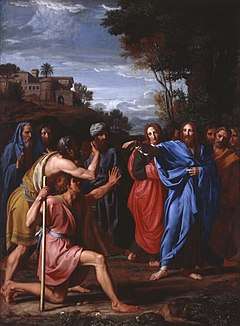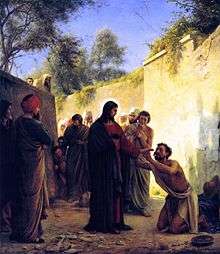Healing the man blind from birth
The miracle of healing the man born blind is one of miracles of Jesus in the Gospels.


Biblical accounts

According to the Gospel of John, 9:1–12,[1] Jesus saw a man who had been blind since birth. His disciples asked him, "Rabbi, who sinned, this man or his parents, that he was born blind?"
Jesus replied:
Neither this man nor his parents sinned," said Jesus, "but this happened so that the works of God might be displayed in him. As long as it is day, we must do the works of him who sent me. Night is coming, when no one can work. While I am in the world, I am the light of the world.
Having said this, he spat on the ground, made some mud with the saliva, and put it on the man's eyes. Like the Lord God who formed Adam from the dust of the earth, Jesus makes clay and creates a new man.[2] "Go," he told him, "wash in the Pool of Siloam" (this word means "Sent"). So the man went and washed, and came home seeing. The architectural setting of the miracle is symbolic, which the above aside establishes with a verbal thread (leitwortstil). Just as Jesus was sent by the Father to give light/enlightenment, the One Sent (cf. John 5:38; 8:42; 9:4; 13:20) sends the man to a pool that means “Sent” to receive sight/insight,[3] and to bring light to a dark world.[4]
His neighbors and those who had formerly seen him begging asked, "Isn't this the same man who used to sit and beg?" Some claimed that he was. Others said, "No, he only looks like him." Both conclusions are correct. He is the same and not the same; he is the man who used to sit and beg, yet he is a new person.[5] But he himself [the healed man] insisted, "I am the man,” or simply, “I am” (egō eimi). His self-affirmation mimics Jesus' egō eimi. Although he does not take on the identity of the divine, he finds his identity in an encounter with the divine.[6]
"How then were your eyes opened?" they asked. He replied, "The man they call Jesus made some mud and put it on my eyes. He told me to go to Siloam and wash. So I went and washed, and then I could see."
"Where is this man?" they asked him. "I don't know," he said.
In this miracle, Jesus applies the title Light of the World to himself in John 9:5, saying:[7]
- When I am in the world, I am the Light of the World.
This episode leads into John 9:39 where Jesus metaphorically explains that he came to this world, so that the blind may see.[7]
Tradition
According to Christian tradition, the man's name was Celidonius.
See also
- John 9
- Life of Jesus in the New Testament
- Ministry of Jesus
- Parables of Jesus
- Light of the World
- Seven signs in the Gospel of John
References
- "Biblegateway John 9:1–12". Biblegateway.com. Retrieved 2018-04-18.
- Jonathan Bishop, “Encounters in the New Testament,” in Literary Interpretations of Biblical Narratives, ed. Kenneth R. R. Gros Louis, 2 vols. (Nashville: Abingdon, 1974-1982), 2:285-94 at 2:287.
- James L. Resseguie, Narrative Criticism of the New Testament: An Introduction (Grand Rapids, MI: Baker Academic, 2005), 149.
- Andy M. Reimer, “The Man Born Blind: True Disciple of Jesus,” In Character Studies in the Fourth Gospel: Narrative Approaches to Seventy Figures in John, ed. Steven A. Hunt , D. Francois Tolmie et al (Grand Rapids, MI: Eerdmans, 2016), 428-438, at 432.
- Paul Duke, Irony in the Fourth Gospel (Atlanta: John Knox, 1985), 119; Resseguie, The Strange Gospel: Narrative Design and Point of View in John (Leiden: Brill, 2001), 141; J. Warren Holleran, “Seeing the Light: A Narrative Reading of John 9,” ETL 69 (1993): 5-26, 354-82, at 361.
- Bishop, 288.
- Matera, Frank J. New Testament Christology. Louisville, Ky. : Westminster John Knox Press, 1999, 235.
